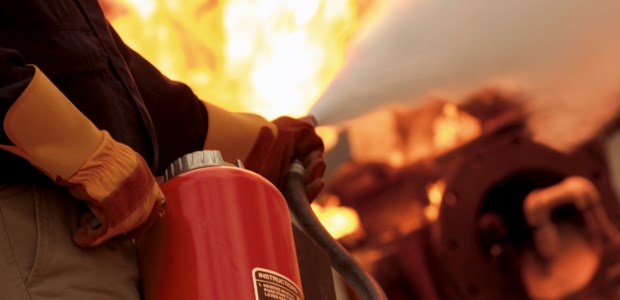
Taking Control with the Right Flow, the Right Extinguisher for Class B Fire Suppression
Is your plant prepared for pressurized flammable liquids and pressurized gas fires?
- By Sam Boraas
- Apr 01, 2018
Let's set the scene. Despite an industrial safety team's most adept practices to manage a propane storage tank, a leak suddenly erupts from a pipe. In a perfect storm of events, a spark follows. There is ignition. Instantly, there is a fire.
In an ideal scenario, safety team members swiftly respond and take control of this hazard. This team is able to shut off the fuel source and suppress the fire using the right technique and the right equipment. Among their equipment, there is a cartridge-operated portable fire extinguisher designed with the high agent flow rate required to take control of that pressurized propane fire. More specifically, it's an extinguisher in compliance with National Fire Protection Association (NFPA) 10, Standard for Portable Fire Extinguishers, Subsection 5.5, Selection for Specific Hazards. This mandate establishes the standard for minimum size and flow rate for portable fire extinguishers used against Class B fires.
Setting Standards to Change Mindsets
Prior to 2007, this specific NFPA 10 standard did not exist in its current language. Earlier editions instructed safety professionals to follow manufacturers' recommendations for the best applications of fire extinguishers. Without an industry-wide standard to follow, inconsistencies among those recommendations contributed to confusion over what is the best tool for protecting facilities against Class B fire scenarios.
Then, the benchmark was set in 2007. NFPA 10 Subsection 5.5 mandated "large-capacity dry chemical extinguishers of 10 lb (4.54 kg) or greater and a discharge rate of 1 lb/sec (0.45 kg/sec) or more shall be used" for pressurized flammable liquid and gas fires. In addition, this exact mandate was also applied to other Class B fires, specifically three-dimensional and obstacle fire scenarios.
Why High-Flow Extinguishers for High-Risk Environments?
"The 2007 NFPA 10 mandate has helped to initiate a change in the mindset of safety teams in high-risk environments," said Dennis D. Brohmer, Johnson Controls Senior Applications Specialist. "However, there's definitely still more work to do in educating teams about how crucial it is to meet this standard. It's all about what's best for the people who are on the front lines of these fire hazards and helping to get the right tools in their hands so they have the best opportunity to put out these fires faster."
An important detail of the propane storage tank fire example is the use of a high-flow, cartridge-operated fire extinguisher to take control of the situation. Industry professionals might ask why high-flow extinguishers like this perform better and are now mandated in high-risk environments with flammable liquids or gases. This is a common question, particularly in the misconceptions that exist around UL-ratings.
The greater effectiveness of high-flow fire extinguishers comes down to speed and flow rate. NFPA 10 addresses and standardizes this essential feature directly—i.e., the requirement for a minimum one pound per second discharge rate. It is true that stored pressure fire extinguishers offer a slower flow rate and longer discharge time of the dry chemical agent. Such fire extinguishers also receive a higher UL rating than high-flow models. However, the slower flow of these stored pressure extinguishers is less effective on Class B pressurized flammable liquids and gas fires. Specialized high-flow fire extinguishers, on the other hand, meet or exceed the minimum one pound per second flow rate required for these fire scenarios.
"These pressure-related fire hazards are incredibly varied," said Brohmer. "Whether it's a paint spray operation, gasoline fuel pumps, processing equipment, high-pressure hydraulic equipment, or LPG tanks, operators need an extinguisher that delivers a lot of agent and delivers it fast. In the end, it's going to help protect people and property."
Over and Above High-Flow Performance
Beyond achieving the NFPA 10 minimum one pound per second flow rate, cartridge-operated fire extinguishers offer additional performance enhancements. In comparison to stored pressure extinguishers, cartridge-operated models offer safety personnel the ability to recharge the extinguisher on site without the need for a trained service technician. This means operations can resume within minutes after an extinguisher has been discharged in response to a fire.
Ergonomic design features of cartridge-operated models also enhance and optimize the operator's effectiveness against Class B fires. Whether it's easier hand portability with 45-degree-angle carrying handles or greater accuracy with specialized nozzles designed to point at the base of the fire when squeezed, high-flow, cartridge-operated fire extinguishers give personnel the higher level of performance they need to comply with NFPA 10 standards.
"Let's face it, these environments are tough," added Rae Lynn Kolbas, Johnson Controls Global Product Manager. "The highest-quality cartridge-operated extinguishers are going to be the ones that withstand the everyday abuses of these industrial settings. This means heavier-gauge steel shells, fewer potential leak paths, and, as a direct result of the cartridge operation, these extinguishers naturally resist the agent compaction effects of vibrations."
Moving Forward in Class B Fire Settings
All fires, whatever the classification, require urgent and appropriate responses. However, pressurized flammable liquids and gases, gravity fed, or obstacle fires all necessitate a unique and specialized response. NFPA 10 gives industrial safety teams a simple, vital tool to assess preparedness levels of their operations: an easy-to-follow standard for one pound per second of agent flow rate.
What this simple standard reinforces about these Class B fire scenarios is, speed matters. Time matters. Technique matters. Agent flow rate makes a critical difference.
This article originally appeared in the April 2018 issue of Occupational Health & Safety.